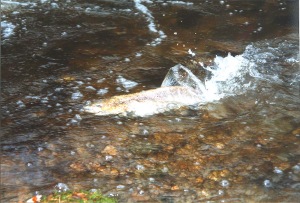Atlantic salmon (Salmo salar)
The River Wye was once one of the greatest salmon rivers in the world and was famed particularly for the size of its fish. It is still notable for its high number (around 75% of the stock) of early running multi sea winter salmon. Between the 1970's and 2002 the river’s salmon suffered a continuous decline and despite a recovery in the past 8 years, stocks are still only around 15% of previous levels. The Atlantic salmon is an “anadromous species”, in other words, adults migrate from the sea to breed in freshwater. Spawning takes place in a depression in the clean gravel of the riverbed (called a ‘redd’), excavated by the hen fish in the late autumn/early winter. In spring the young fry emerge to spread out into other parts of the river (commonly up to 2km from the redd site) and compete with each other for habitat. In this stage losses are high and as little as 10% survive to the next winter. Their second year in freshwater they are called 'parr'. Once they have reached 120mm in length they take on a silvery colour and migrate downstream to the sea as 'smolts' during in April and May. Salmon have a specialised homing instinct that draws them back to spawn in the stream of their birth after 1-4 years in the sea. This behaviour has resulted in local adaptations and a stock that is genetically distinct between rivers and even between separate tributaries. Atlantic salmon can be found across Europe from Portugal in the south to Sweden and Finland in the north. The UK salmon population comprises a significant proportion of the total European stock. The species is subject to many pressures including pollution, the introduction of non-native salmon stocks, physical barriers to migration, exploitation from netting and angling, physical degradation of spawning and nursery habitat, and increased marine mortality due to problems within the marine environment.
Salmon quite often leap clear of the water when they are migrating upstream or when they are resting. This presents the best, albeit brief, opportunity to see them. Please be extremely careful when navigating the Wye and Usk (or any other river that contains salmon), especially from November to March. Salmon eggs in the gravel are extremely sensitive during the first few weeks after spawning and the merest touch will damage or kill them. Avoiding contact with river gravels is good practice throughout the year in fact, as other fish species will use the same areas for spawning at other times in the year. You also need to be aware that wilful disturbance of spawning fish or their offspring is an offence under the Salmon & Freshwater Fisheries Act.


